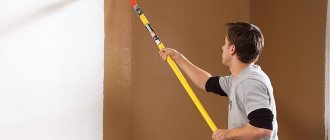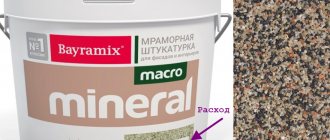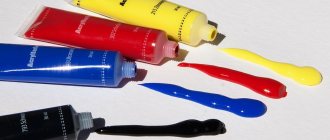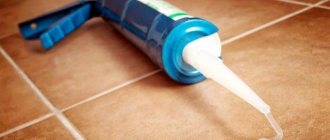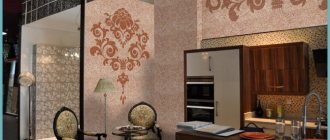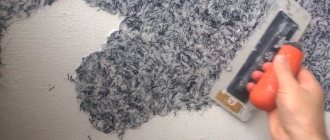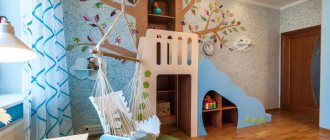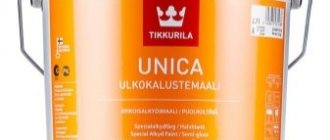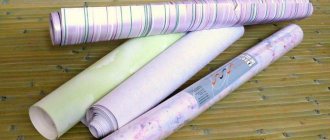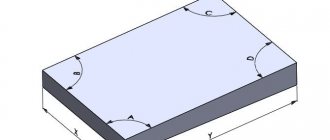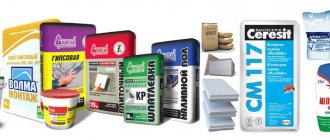Among the huge variety of decorative finishing materials, liquid wallpaper takes a leading position due to its affordable price, ease of application and high performance characteristics.
When purchasing liquid wallpaper, the mixture consumption per 1 sq. m. can be found out from the table located on the product packaging.
Repairing and finishing a wall requires determining the exact amount of materials needed.
Let's consider how to calculate the amount of liquid wallpaper per room so that there is enough to decorate the surfaces and there is no large surplus left.
What is liquid wallpaper
Liquid wallpaper is a textured finishing material for ceilings and walls, reminiscent of decorative plaster.
They differ from rolled paper wallpapers in their application technology, the absence of seams and the ability to decorate any curved surfaces. Compositions are made from silk, cotton or cellulose fibers and dry KMS glue. To improve aesthetic and performance properties, plasticizers, dyes, mineral chips, colored balls, glitter or mother-of-pearl can be added to the mixture. Supplied dry in sealed bags. Each package has instructions for preparing and applying the mixture, where you can see how much material is needed to decorate one square of surface.
The solution is prepared by adding warm water to the dry composition and thoroughly mixing with your hands. After the mass has swollen for 8-10 hours, you can begin finishing work.
The finished solution is applied to the wall with a trowel or spatula. The mixture is distributed over the surface using a plastic grater. With a special roller you can create relief patterns and ornaments.
Liquid wallpaper can also be applied mechanically, using a spray gun. This method will create a more uniform and thin layer, and significantly reduce the work time.
Compared to decorative plaster, applying liquid wallpaper is much easier and simpler.
The finish is environmentally friendly, safe and highly vapor permeable. All these factors provide a comfortable and healthy indoor microclimate, which allows them to be used for decorating children's rooms, bedrooms and living rooms.
Application methods
You can apply the paint manually using a spatula or a roller with a special attachment. To apply more liquid wallpaper compositions, you can use a Hopper spray gun. In this case, the material consumption is reduced by 1 sq. m.
With any method of work, the coating is applied from the corner of the wall or its edge. The movements of the tool during manual laying should occur in one direction. The pressing force of the spatula must be chosen in such a way that a beautiful textured layer is obtained. Weak pressure will result in an uneven thick coating and increase material consumption.
First, apply a thin layer, and after it dries, apply the main coating. To create a textured surface, the first layer is rolled immediately with a roller. The coating will be ready for use after complete drying. This occurs within 12-72 hours, depending on the type of wallpaper, layer thickness, humidity and room temperature.
To evenly distribute the material over a large area, it would be rational to use a spray gun. They are comfortable working with complex surfaces: niches, smooth transitions, curves. It is appropriate to use it with a large number of decorative elements - bas-reliefs, stucco moldings.
Coating is carried out in two steps. First, the first (rough) layer is sprayed, and as it dries, the second, finishing, is applied. This prevents the thick layer of material from slipping.
Weak pressure will result in an uneven thick coating and increase material consumption.
Calculation of the processed area
Standard material consumption is usually indicated on the packaging.
To calculate how much liquid wallpaper is needed, perform the following steps:
- We determine the area of all walls by multiplying the perimeter of the room by the distance from floor to ceiling.
- We calculate the area of windows and doors by multiplying their width by height.
- From the area of the walls, we subtract the area of doors and windows to obtain the area of the walls to be finished.
- We determine the ceiling area by multiplying the width and length of the room.
- By adding up the areas of all walls minus windows and doors and the area of the ceiling, we get the total area of the surfaces being treated.
- By multiplying the resulting indicator by the standard mixture consumption, we obtain the exact material consumption required for the entire volume of work.
We divide premises of complex configuration into separate sectors, determine the areas of individual parts and sum them up.
If calculated correctly, one kilogram of dry mass should be enough for 4-5 square meters of manual application in a layer of up to 2.5 millimeters. With mechanized application, a kilogram is enough for 6-7 squares of wall.
Buy dry mixture 10-15% more than is necessary according to calculation, so that there is a reserve in case of correction of errors during application, damage to decorative coatings or other unforeseen situations.
Calculation example
For those who do not trust the calculator too much and prefer to carry out the calculations themselves, we offer an example of how to calculate liquid wallpaper for the complete decoration of a room, taking into account the necessary reserve.
Initial data: a room measuring 5x6 m, height 3.2 m. Two windows measuring 1.5x1.5 m, arched entrance opening 3x2 m. Finishing the walls with liquid wallpaper to the full height, suspended ceiling.
We use liquid wallpaper from Silk Plaster (Russia), Rekot series (based on natural wood) with a consumption of 7 sq. m. from the packaging.
Total area to be finished
(5+6+5+6)x3.2-2x1.5x1.5-3x2 = 59.9 sq.m.
Round up to 60 sq.m. For such an area you will need 60/7 = 8.5 packages of dry mixture. Accordingly, you need to purchase 9 pieces. Considering that liquid wallpaper is not the most mechanically resistant material and the finish may require repairs during use, it is better to buy ten packs at once. When sealed, the dry mixture can be stored indefinitely and will allow you to restore the integrity of the coating at any time.
What affects material consumption
Consumption directly depends on the skill of the finisher. With proper preparation of the composition and professional application, it will be minimal.
Calculation of the amount of decorative material must be done in advance in order to know the total cost of repair work and purchase the exact amount of liquid wallpaper. Consumption rates per 1 m2 of coating average 200-300 grams of dry mixture. The consumption table on material packages does not always correspond to actual indicators.
When buying liquid wallpaper, you must take into account that the consumption of one package depends on various factors:
- a surface that is too smooth makes it difficult to apply and control the thickness of the layer; a textured surface will require the application of a thicker layer in certain areas;
- dark walls can be visible through the decorative coating and will result in an increase in the layer;
- the use of a composition that has been stored diluted for a long time, as well as violation of the preparation technology, will affect the thickness of the layer and lead to excess consumption of material;
- the presence of potholes and cracks on the base for finishing entails exceeding the standard mixture consumption.
A properly prepared surface helps to significantly reduce the consumption of decorative composition due to the possibility of applying a minimally thin layer.
Calculation of consumption and cost of liquid wallpaper
Decorative plaster calculator - calculate the cost of materials for your room or home in a few seconds!
We care about our customers and have created this page specifically for your convenience. Here you can calculate in a matter of seconds how much the decorative silk plaster material needed to cover the walls in any room will cost, and buy the option that suits you in 2 clicks.
When blank, you see a price list for silk wallpaper, which states:
- Price for 1 package of liquid wallpaper of each type presented on our website.
- Consumption of one package*, i.e. how many sq.m. 1 package of each type of decorative plaster is enough.
| Name | Price 1 package | Consumption of 1 package | You need | Price |
| Master | 265.00 rub. | 4.5 sq.m | ||
| Master Silk – Economy wallpaper | 325.00 rub. | 5 sq.m | ||
| Master Silk | 560.00 rub. | 5 sq.m | ||
| Optima | 640.00 rub. | 4 sq.m | ||
| Standard | 695.00 rub. | 4 sq.m | ||
| Relief | 715.00 rub. | 3 sq.m | ||
| Fort | 790.00 rub. | 3 sq.m | ||
| Prestige | 835.00 rub. | 3.5 sq.m | ||
| Recoat 1 | 860.00 rub. | 7 sq.m | ||
| Provence | 875.00 rub. | 3.5 sq.m | ||
| Art design 1 | 975.00 rub. | 3 sq.m | ||
| Victoria | 1025.00 rub. | 3.5 sq.m | ||
| Art design 2 | 1095.00 rub. | 3 sq.m | ||
| Air line | 1265.00 rub. | 3.5 sq.m | ||
| Recoat 2 | 1270.00 rub. | 7 sq.m | ||
| Ecoline | 1335.00 rub. | 4 sq.m | ||
| Miracle Collection | 1385.00 rub. | 3 sq.m | ||
| Ecodecor | 1405.00 rub. | 4 sq.m | ||
| Premium | 1485.00 rub. | 3 sq.m | ||
| Recoat 3 | 1600.00 rub. | 7 sq.m | ||
| West | 1660.00 rub. | 3.5 sq.m | ||
| South | 1720.00 rub. | 3.5 sq.m | ||
| Nord | 1835.00 rub. | 3.5 sq.m | ||
| Mixart | 1998.00 rub. | 6 sq.m | ||
| East | 2030.00 rub. | 3.5 sq.m | ||
| Silk plaster La Loire | 3049.00 rub. | 5 sq.m | ||
| Victoria Du Monde Collection - Silver | 3493.00 rub. | 5 sq.m | ||
| Silk plaster Versailles II | 4252.00 rub. | 4.5 sq.m | ||
| Victoria Du Monde Collection - Gold | 4542.00 rub. | 5 sq.m | ||
| Trowel (grater, spatula) trapezoid, transparent PP SP1 | 275.00 rub. | |||
| Sequins Silk Plaster | 50.00 rub. | |||
| Large trowel | 250.00 rub. | |||
| Equipment set SILK PLASTER SPG 500 | 31510.00 rub. | |||
| Equipment set SILK PLASTER SPG 360 | 19320.00 rub. | |||
| Gun for applying liquid wallpaper | 8144.00 rub. | |||
| Trowel (grater, spatula) trapezoid, opaque ABSProfi No. 2 | 336.00 rub. | |||
| Trowel (grater, spatula) trapezoid, transparent SProfi No. 3 | 350.00 rub. | |||
| Large rectangular trowel | 265.00 rub. | |||
| Mini sequins Silk Plaster | 60.00 rub. | |||
| Varnish for liquid wallpaper | 375.00 rub. | |||
| Varnish for liquid wallpaper and decorative plaster 5 l | 1665.00 rub. | |||
| Primer for liquid wallpaper Silk Plaster (5l) | 1030.00 rub. | |||
| Primer for liquid wallpaper Silk Plaster (0.8kg) | 307.00 rub. |
How to reduce consumption
You can reduce the consumption of liquid wallpaper when finishing walls and ceilings in various ways:
- when applying liquid wallpaper using a spray gun, you can achieve a minimum thickness of no more than 1 millimeter;
- careful leveling of the base and applying a layer of primer under liquid wallpaper will reduce material consumption by reducing the thickness of the coating;
- perfectly white putty will prevent thin layers of finish from showing through;
- thorough mixing of the material will avoid the formation of lumps and clots of cellulose fibers and reduce the thickness of the decorative layer;
- By using dissolved remnants of the previous coating in your work, you can save on the purchase of new material.
An important point in saving decorative composition is experience and skill in application. When doing the work for the first time, it is unlikely that you will be able to maintain a uniform thickness of the coatings.
Ways to reduce the consumption of liquid wallpaper
Preparing the walls
We refute the idea that liquid wallpaper is very expensive. This myth is based on incorrect and insufficient preparation of the walls. For some reason, among the advantages of liquid wallpaper, it is customary to point out and praise the ability to mask wall imperfections. It turns out that their leveling occurs not due to cheap materials, but due to expensive ones. Consumption will be significantly reduced if the walls meet the following requirements:
- Surface uniformity – whitewash, paint, wallpaper residues, etc. are removed. Puttying work is carried out to remove unevenness and other defects. The entire wall is plastered so that it has the same working surface in all areas.
- The wall needs a primer that will prevent moisture absorption and add strength to it.
Important: if the wall has a dark color, then it can be visible even after applying and drying wallpaper in light shades. Before applying wallpaper, you must paint the wall white. This can be done using facade paints or water-based paints.
Summary of wall preparation
Now the wall is completely ready and is a reliable surface that will not “eat up” extra pounds of liquid wallpaper due to holes from nails, cracks and dents, etc.
We continue to save - we work correctly
The thickness of the layer applied to the wall should be approximately 2mm to 3mm, unless other optimal parameters are indicated on the packaging. These values should not be exceeded in order to achieve the best coating strength and increase its service life. The thicker the layer of wallpaper (not provided for in the instructions), the harder it becomes to work with it, the drying time increases and the appearance may leave much to be desired. In order for the mixture to lie on the surface evenly and in the desired layer, you need to use one little trick. When working to distribute wallpaper on the wall, you need to rub it in different directions, and not in any one direction. The more you work during this process, the better the result will be.
If you have several packs of wallpaper, this does not mean that having used one, you will then mix another with water and continue working on the wall. The wall must be covered immediately and completely. Different batches of seemingly the same composition may not match in shade.
Work starts from the corner and then moves towards the center. Having finished covering the wall, you need to use a portable light source, such as a flashlight, and inspect the work surface for defects - unevenness, poorly worn places, etc. They must be eliminated immediately.
Experience becomes very important in saving materials. Alas, if it is missing, then the consumption of liquid wallpaper will probably exceed the norm.
Advantages of liquid wallpaper
Liquid wallpaper has become so popular for a reason. They are very beautiful and easy to work with. The list of their advantages is truly impressive
- A unique composition that includes cellulose fibers, cotton, silk, etc. Improved decorative properties are created by including a variety of sparkles. Thanks to liquid wallpaper, the interior of the room changes beyond recognition. The walls become not only extremely beautiful in appearance, but also very pleasant to the touch. The coating does not absorb foreign odors, its color is highly resistant. In addition, it significantly increases the thermal insulation and sound insulation values of the walls.
- The strength of the wallpaper is achieved through the use of KMS glue. The ease of application can hardly be overestimated. In particularly difficult places, such as corners, niches and other curved parts of walls, it is very difficult to work with conventional types of rolled wallpaper, because it becomes important to maintain the accuracy of the fit, the impregnation time of the wallpaper, and the thorough preparation of the wall surface. The liquid version of the wallpaper can be applied to any area with a spatula, as when working with putty or a special grater.
- If surface defects occur during its operation, it will not be difficult to put the damaged area in order.
- Easy to apply - no complicated work. Absence of rotting processes and the appearance of fungus due to special additives. If liquid wallpaper is varnished, it will acquire the properties of washable types. Now they can be cleaned not only with a vacuum cleaner, but also with a damp cloth.
- Environmental safety of the composition. During the work process, you can work with wallpaper without protective gloves.
- The remaining unused mixture will not be lost. They are hermetically sealed and put away until the time when something needs to be adjusted or supplemented. Liquid wallpaper has been on sale for quite some time, but according to surveys, many people have not yet come across them and have not chosen them for wall decoration. This probably happens due to a poor understanding of coating technology and the generally accepted opinion that they are expensive. In order to make the right choice, you only need the information listed above. Now you can easily calculate the cost of giving your walls a spectacular look and use all the ways to save liquid wallpaper.
A pleasant surprise will be the opportunity to feel like a designer, since various decorative sparkles and additives can be mixed into liquid wallpaper. Whether you want gold or silver walls, no problem, liquid wallpaper can handle that too.
The technology for applying liquid wallpaper can be seen in the following video:
You can learn in detail about the methods of making drawings with liquid wallpaper, their types, the choice of liquid wallpaper for various rooms and their restoration in the article: liquid wallpaper, types, application, drawings.
Control batch
The actual consumption of liquid wallpaper per 1 square meter may differ significantly from that indicated by the manufacturer on the packaging. This difference is not particularly important when using cheap, budget material made from cellulose or cotton fibers.
When using expensive materials made from artificial or natural silk, the cost of each package matters.
Before purchasing a dry mixture, it is worth making a test batch and applying the solution to a small section of the wall, which can later be hidden by furniture. This will make it clear how many squares the package of decorative coating is enough to calculate the required amount of liquid wallpaper and purchase more if necessary.
Instructions for applying liquid wallpaper (video)
If you have decided to refresh your walls using liquid wallpaper, you should definitely read the instructions for their use. Using such wallpaper is very convenient and pleasant, but you should take into account some nuances. In order to avoid incidents with the amount of wallpaper, you first need to make correct calculations of their use. Next, decide on the method of applying them to the walls. The application procedure itself is pleasant and does not cause much trouble. If there are consumables left, do not throw them away. If stored properly, they will serve well.
Today we will talk about liquid wallpaper and such important points as the price of packaging liquid wallpaper, its weight and consumption.
When it comes to the advantages of liquid wallpaper, you can only hear positive and enthusiastic reviews from those who have already used this type of wall covering. But you can also hear the opinion that they are still expensive and such repairs significantly hit the pocket. Is it true that liquid wallpaper has a high consumption per square meter and, as a result, turns out to be a very expensive material? In order to answer this question, you need to start with the packaging of this wallpaper and its characteristics.
How to use leftover material
It is allowed to store diluted liquid wallpaper for no more than 2-3 days in a cool place.
If you have prepared more liquid working solution than needed, dry the remaining unused material by spreading it in a thin layer on plastic film. After drying, the mixture must be thoroughly fluffed, placed in a plastic bag, releasing the air from it, and tied tightly. Wallpaper of different colors and textures should be stored in separate bags.
The dried composition is suitable for long-term storage in a dry, dark place, and to work you only need to dilute it with water.
Liquid decorative wallpaper is a unique material that allows it to be used by families with small children and pet owners.
Due to the supply of unused composition, you can quickly and easily restore any damage to decorative coatings.
